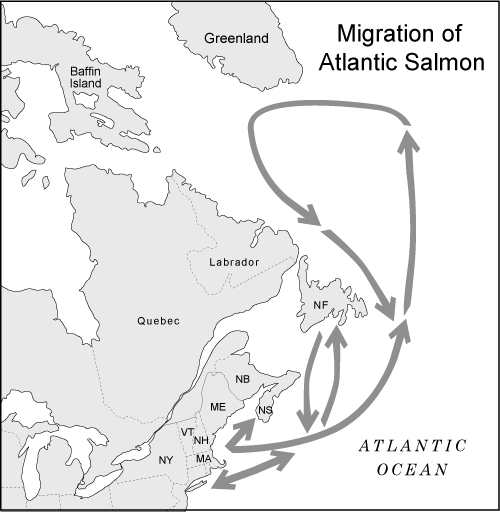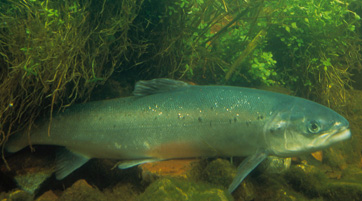Atlantic salmon (Salmo salar)
Status | Taxonomy | Species Description | Habitat | Distribution |
Population Trends | Threats | Conservation Efforts | Regulatory Overview |
Key Documents | More Info
Status
ESA Endangered - Gulf of Maine Distinct Population Segment (DPS)
Proposed ESA Endangered - Atlantic salmon in Maine outside of the Gulf of Maine DPS
ESA Species of Concern - Atlantic salmon in Maine outside of the Gulf of Maine DPS
Taxonomy
Kingdom: Animalia
Phylum: Chordata
Class: Osteichthyes
Order: Salmoniformes
Family: Salmonidae
Genus: Salmo
Species: salar
Species Description
The average size of Atlantic salmon is 28-30 inches (71-76 cm) long and 8-12 pounds (3.6-5.4 kg) after two years at sea. Although uncommon, adults can grow to be as large as 30 pounds (13.6 kg).
Atlantic salmon have a relatively complex life history that includes spawning, juvenile rearing in rivers, and extensive feeding migrations on the high seas. As a result, Atlantic salmon go through several distinct phases that can be identified by specific changes in behavior, physiology, and habitat requirements.
Juvenile salmon feed and grow in rivers for one to three years before undergoing "smoltification" and migrating to the ocean. Atlantic salmon of U.S. origin are highly migratory, undertaking long marine migrations between the mouths of U.S. rivers and the northwest Atlantic Ocean where they are widely distributed seasonally over much of the region. Most Atlantic salmon of U.S. origin spend two winters in the ocean before returning to freshwater to spawn. Those that return after only one year are called grilse. In the United States, most adult Atlantic salmon ascend the rivers of New England beginning in spring and continuing through the fall, with migration peaking in June.
Habitat
The Atlantic salmon is an anadromous fish, typically spending 2-3 years in freshwater, migrating to the ocean where it also spends 2-3 years, and then returning to its natal river to spawn.
Suitable spawning habitat consists of gravel or rubble in areas of moving water. Eggs hatch in March or April and become fry.
 |
| Map: Migration of Atlantic salmon |
Fry remain buried in the gravel for about six weeks. The fry emerge from the gravel about mid-May and start feeding on plankton and small invertebrates. Emergent fry quickly disperse from nests within the gravel (called redds). They develop camouflaging stripes along their sides, and enter what is termed the parr stage.
Parr habitat, often called "nursery habitat," is typically riffle areas characterized by adequate cover, shallow water depth, and moderate to fast water flow.
Salmon parr spend 2-3 years in freshwater and then undergo a physiological transformation called smoltification that prepares them for life in a marine habitat.
Atlantic salmon leave Maine rivers in the spring and reach Newfoundland and Labrador by mid-summer. They spend their first winter at sea south of Greenland.
After the first winter at sea, a small percentage return to Maine while the majority spend a second year at sea, feeding off the southwest or, to a much lesser extent, the southeast coast of Greenland. Some Maine salmon are also found in waters along the Labrador coast.
After a second winter in the Labrador Sea, most Maine salmon return to rivers in Maine, with a small number returning the following year as what is referred to as three sea winter fish.
In September 2008, NMFS proposed critical habitat for the Gulf of Maine DPS [pdf].
Distribution
There are three generally recognized groups of Atlantic salmon: North American, European, and Baltic. Atlantic salmon reproduce in coastal rivers of northeastern North America, Iceland, Europe, and northwestern Russia and migrate through various portions of the North Atlantic Ocean. European and North American populations of Atlantic salmon intermix during their at-sea stage, where they share similar summer feeding grounds off Greenland.
The North American group historically ranged from northern Quebec southeast to Newfoundland and southwest to Long Island Sound. It includes Canadian populations and U.S. populations, including the listed Gulf of Maine DPS. In Canada, significant reproducing populations remain throughout the historic range, though many populations are severely depleted.
Population Trends
By the early 19th century, Atlantic salmon runs in New England, which historically occurred in almost every major river north of the Hudson River, were severely depleted. Overexploitation, degradation of water quality, and damming of rivers were large contributors to the historical decline in abundance. By the end of the 19th century, Atlantic salmon had been extirpated from three of the five rivers with the largest populations (Androscoggin, Merrimack, and Connecticut). In general, the abundance of Atlantic salmon continued to decline in all rivers through the first half of the 20th century. The primary distribution of Atlantic salmon in the United States by the mid-20th century was, except for a few remnant populations, limited to the eastern third of Maine's coast.
Even with current conservation efforts, returns of adult Atlantic salmon to the Gulf of Maine DPS rivers remain extremely low. The 2006 status review [pdf] [2.8 MB] reports an estimated extinction risk of 19% to 75% within the next 100 years for the Gulf of Maine DPS even when current levels of hatchery supplementation are considered.
The populations of Atlantic salmon present in the Gulf of Maine DPS represent the last wild populations of U.S. Atlantic salmon. At the time of listing under the ESA in 2000, there were at least eight rivers in the geographic range of the DPS known to still support wild Atlantic salmon populations:
- Dennys river
- East Machias river
- Machias river
- Pleasant river
- Narraguagus river
- Ducktrap river
- Sheepscot river
- Cove Brook
There are at least fourteen small coastal rivers within the historic range of this DPS from which wild salmon populations have already been extirpated.
- Acidified water and associated aluminum toxicity, which decrease juvenile survival
- Aquaculture practices, which pose ecological and genetic risks
- Avian (bird) predation
- Changing land use patterns (e.g., development, agriculture, forestry)
- Climate change
- Degradation of water quality (e.g., contaminants, nutrient enrichment, elevated water temperature)
- Hatchery programs (potential for artificial selection/domestication)
- Incidental capture of adults and parr by recreational fishermen
- Non-native fish species that compete with or prey on Atlantic salmon
- Loss of habitat complexity and connectivity
- Poaching of adults in rivers with listed Atlantic salmon
- Sedimentation
- Water extraction
Conservation Efforts
The State of Maine ![]() prepared a Conservation Plan for Atlantic salmon
prepared a Conservation Plan for Atlantic salmon ![]() and is a key partner in the recovery efforts for the species. The Maine Conservation Plan contains a number of actions and measures to reduce potential impacts to Atlantic salmon from recreational fishing, agriculture, aquaculture, and forestry.
and is a key partner in the recovery efforts for the species. The Maine Conservation Plan contains a number of actions and measures to reduce potential impacts to Atlantic salmon from recreational fishing, agriculture, aquaculture, and forestry.
The federal Recovery Plan [pdf] [2.3 MB] was developed in close cooperation with Maine, and many of its elements are based on the Maine Conservation Plan.
In addition to efforts to reduce threats to the species, river-specific Atlantic salmon are being stocked. The final rule to list the DPS as endangered [pdf] acknowledged the considerable efforts being put forth by the State of Maine and public and private sector partners to protect Atlantic salmon, but pointed out that, despite these efforts, the DPS is in danger of extinction.
Regulatory Overview
On November 17, 2000, NMFS and the U.S. Fish and Wildlife Service (FWS) published a final rule to list the Gulf of Maine DPS as an endangered species (65 FR 69459 [pdf]). The DPS includes all naturally reproducing remnant populations of Atlantic salmon from the Kennebec River downstream of the former Edwards Dam site northward to the mouth of the St. Croix River. Atlantic salmon in Maine outside of the range of the Gulf of Maine DPS were designated as a Species of Concern in 1997.
On December 20, 2005, NMFS and FWS announced the availability of the Final Recovery Plan for the Gulf of Maine DPS of Atlantic Salmon (70 FR 75473 [pdf]).
A NMFS Status Review [pdf] [2.8 MB] was completed in September 2006. As a result of this status review, the Atlantic salmon in Maine outside of the Gulf of Maine DPS became a candidate species [pdf] (71 FR 61022).
In September 2008, NMFS proposed critical habitat for the Southern DPS [pdf].
Key Documents
(All documents are in PDF format.)
| Title | Federal Register | Date |
|---|---|---|
| Proposed Critical Habitat for the Gulf of Maine DPS | 73 FR 51747 | 09/05/2008 |
| Status Review for Anadromous Atlantic Salmon (Salmo salar) in the United States | 71 FR 55431 | 09/22/2006 |
| Recovery Plan for the Gulf of Maine DPS | 70 FR 75473 | 12/20/2005 |
| ESA Listing Rule for Gulf of Maine DPS | 65 FR 69459 | 11/17/2000 |
- NMFS Northeast Regional Office Atlantic Salmon: An Endangered Population
- NMFS Detailed Atlantic Salmon Fact Sheet [pdf]
- USFWS Atlantic Salmon Species Profile
- Maine Atlantic Salmon Commission

Source: summarized from Status Review for Anadromous Atlantic Salmon (Salmo salar) in the United States (Fay et al. 2006).
